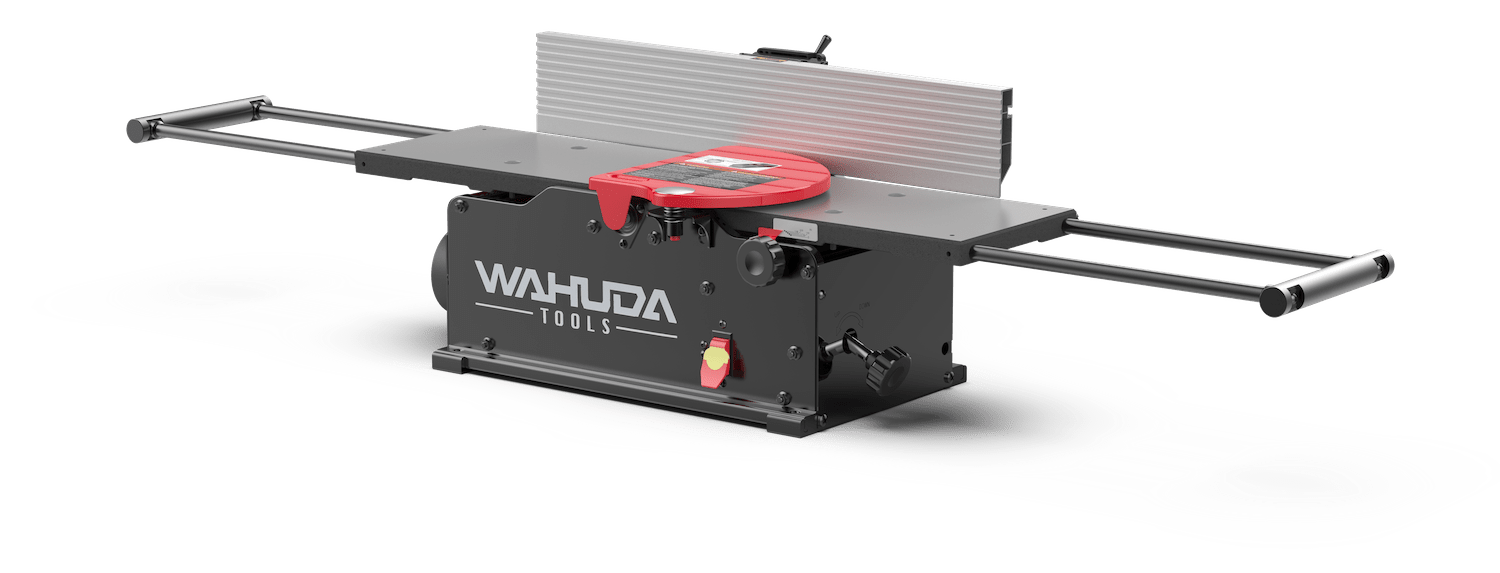What Is a Spiral Cutterhead?
Spiral cutterheads are the new and improved blades for jointers. This innovative technology utilizes insert tooling to make smooth cuts and maintenance a breeze. The first thing you’ll notice is the design. Spiral cutterheads will have a row of carbide cutter head inserts wrapping around a steel head, hence the name “spiral.” There is also a helix design (these are known as helix cutterheads) that uses fewer inserts per row and wraps around the steel head with less of a curve. We’ll get into more of the differences between spiral and helix later. Newer jointer models may come already outfitted with spiral cutterheads (like these Wahuda models), but you can upgrade your older jointer by replacing the cutterhead.
So how does the spiral cutterhead jointer perform? The answer is — great! Due to the way the inserts are situated on the head and how they rotate perpendicular to the jointer feed, you end up with smaller, superior cuts that provide a glass-like finish.
Those who have made the switch to spiral cutterheads have been incredibly pleased by the results. The following are some of the biggest improvements you’ll get with a spiral cutterhead:
- Better cut quality means less scooping and fewer marks compared to straight knife blades.
- Smaller shavings allow for better dust collection.
- It’s a quieter machine, though you’ll still need ear protection.
- It’s easy to maintain. Carbide lasts longer, edges last longer, and all you need to do is rotate to get a fresh blade. Replacing the carbide inserts is easy once they do need to be swapped.
- Fewer replacements mean more money in your pocket!
Maintaining Carbide Inserts in Your Spiral Cutterhead Jointer
Another major improvement with spiral cutterhead jointers is that maintenance is much easier than with traditional straight knife jointers. Each carbide insert has four sharp blades. As a cutting edge dulls, all you need to do is loosen the insert, rotate it to the next edge and tighten the insert back into place. No more sharpening or realignment necessary! With spiral cutterheads, you can get back to your woodworking faster!
Straight vs. Spiral Cutterhead
Straight Knives
+ Cheap
+ Smooth cuts
– Loses sharpness faster than carbide
– Large shavings can quickly fill up a shop vac
– Maintenance, replacement & alignment are time-consuming
Spiral Cutterhead
+ Smooth cuts on fine-grain stock
+ Carbide inserts stay sharper longer
+ Longer time between replacements
+ Inserts are easy to replace
+ Smaller shavings for less dust collection
– Expensive to upgrade jointer to spiral cutterhead
Straight knife blades are the traditional cutterheads you will find in many older or budget jointer models. While they are technically cheaper than spiral cutterheads, straight knife cutterheads actually cost more over time because they require more maintenance and will need to be replaced more often than the carbide inserts. Many woodworkers have found the process of sharpening their straight knives and replacing them to be time-consuming and rather difficult. Spiral cutterheads, however, are easy to maintain and have a much longer use life since all you need to do is rotate the bit to a new edge once the older edge has dulled.
Spiral vs. Helical Cutterhead
- The main difference between spiral and helical is the cutter’s alignment to the axis of the cutterhead and number of inserts.
- Spiral aligns cutting edge to be parallel to the axis of rotation.
- Helical aligns the cut edge so it is rotated 14 degrees off the axis.
Spiral and helical cutterheads share a lot of qualities, and you’ll often hear them talked about interchangeably. While they are very similar, they have one major difference, and that is the way the blades are positioned in the cutterhead. Spiral cutterheads are positioned perpendicular to the jointer feed, whereas helical cutterheads are positioned at an angle to the feed. Spiral cutterheads have a cutting action similar to a hand plane. Helical cutterheads, however, have a sheer or skew-like cut. There is some debate around which type produces a smoother cut, but the majority agrees that any difference is so minimal that there is no clear winner. Basically, you can’t go wrong either way.




0 Comments